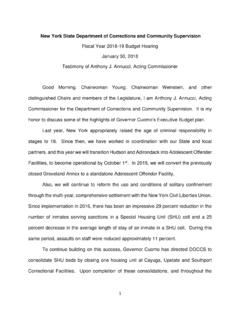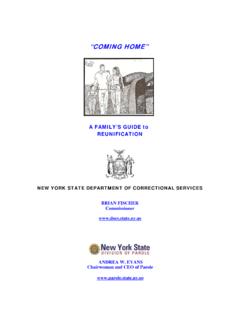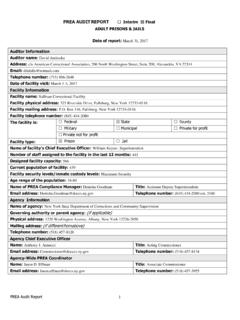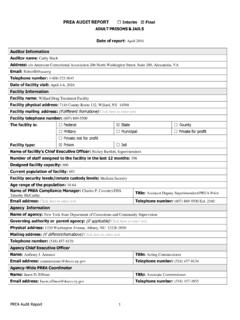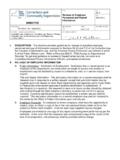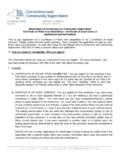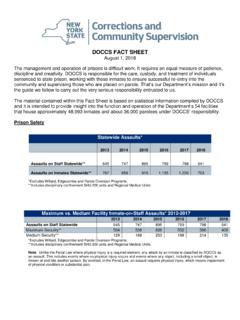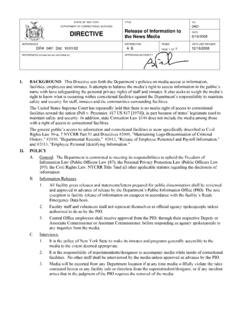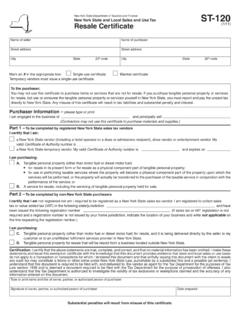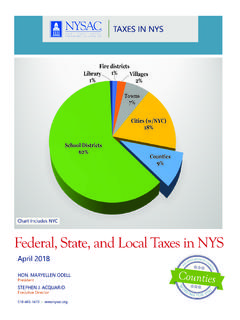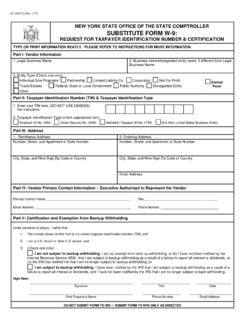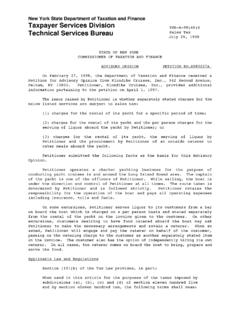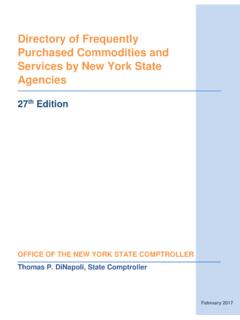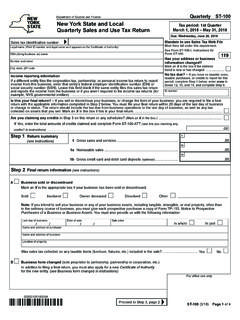Transcription of HANDBOOK FOR THE FAMILIES AND FRIENDS OF NEW …
1 HANDBOOK FOR THE FAMILIES AND FRIENDS . OF NEW york STATE DOCCS INMATES. JULY 2015. ANDREW CUOMO ANTHONY ANNUCCI. Governor Acting Commissioner TABLE OF CONTENTS. DESCRIPTION PAGE. Acknowledgement and Introduction 3. Understanding New york Sate Department of Corrections & Community 4. Supervision Locating an Inmate 5. Sending Mail to an Inmate 6. Packages 7. Telephone Calls 8 9. Visitation 10 - 12. Visiting Guidelines 13 18. Visiting Misconduct/Violations 19. Rules Specific to the Visiting Room 20. Visitor Checklist 21. Transportation 22. Emergencies 23. Grave Illness/Death of a Family Member 24. Inmate Monies/Inmate Accounts 25. Inmate Commissary 26. Inmate Misconduct 27. Inmate Complaints/Grievances 28. General Information About Programs and Services 29 31. Medical/Dental/Mental Health Services 32. Transfers 33. Returning to the Community Community Supervision 34. Frequently Asked Questions 35 37. HANDBOOK Evaluation 38.
2 Appendix A Addresses and Phone Numbers of Facilities in New york State 39 45. Appendix B Mileage Chart 46 48. Appendix C Allowable Items 49 59. Appendix D Programs Serving FAMILIES of Adult Inmates 60 66. Appendix E NYSDOCCS Facilities Map and Regional Map 67. Conclusion 68. 2. ACKNOWLEDGEMENT. This HANDBOOK was revised with the help of many of the divisions within the Department of Corrections and Community Supervision. The HANDBOOK was translated in its entirety, into the Spanish language to supplement the Department's English web site component by the Division of Hispanic and Cultural Services. INTRODUCTION. If you are a family member or friend of a person incarcerated in a state prison, your life has changed in many ways. This time can be painful and difficult for you. You may have lost the person who supported the family financially or who cared for your children. Relatives and FRIENDS may act differently, while others may act as if you are the criminal.
3 In addition, your relationship with the person incarcerated has changed. Your contacts will be subject to the rules of the New york State Department of Corrections and Community Supervision. The inmate loses choices about when he or she can make phone calls or have visits. Family and FRIENDS also lose the freedom' to have spontaneous and unsupervised contact with their incarcerated loved one. Changes have to be made in order to maintain a positive relationship. This HANDBOOK was designed to help you understand more about the New york State correctional system. Hopefully, this will guide you as you cope with these changes in your life. 3. UNDERSTANDING NEW york STATE DEPARTMENT OF CORRECTIONS. AND COMMUNITY SUPERVISION. The New york State Department of Corrections and Community Supervision (DOCCS) is headed by the Commissioner. The Commissioner is responsible for the overall management and operation of the New york State Department of Corrections and Community Supervision to ensure the care, custody, and treatment of individuals sentenced to state prison; as well as those inmates who are under community supervision.
4 The agency employs approximately 30,000 workers and houses approximately 54,000. inmates in 54 correctional facilities. Community Supervision is responsible for the supervision and reintegration of inmates released from prison by action of the New york State Board of Parole, by conditional release, release to a period of post-release supervision or those sentenced to direct parole supervision. There are currently approximately 36,000 parolees under Community Supervision. The Department is not responsible for inmates housed in city or county correctional facilities or local police lock-ups. For information about the local facilities, please contact the city or county facility. Every correctional facility has an administration. These are people who manage the correctional facility. There is a Superintendent, and at most facilities; there are Deputy Superintendents for Security, Programs, and Administration. Security staff consists of Captains, Lieutenants, Sergeants, and Correction Officers.
5 There is also a myriad of Program and Administrative staff from the civilian ranks including Offender Rehabilitation Coordinator, Supervising Offender Rehabilitation Coordinator, Teachers, Education Supervisors, Recreation Program Leaders, Chaplains, Institution Stewards, Nurses, Principal Account Clerks, Maintenance Supervisors, Plant Utilities Engineers, Food Services Administrators and Stores Clerks, to name a few. Generally, staff can be reached during week days, however, Chaplains often are available in the evenings and on weekends. On weekends, holidays, and evenings, there is always the Watch Commander who is the security staff person in charge of the prison. Often, the Chaplains and the Offender Rehabilitation Coordinators are the most helpful with family issues. At Central Office in Albany, there are also Chaplains and Family Services staff who can be contacted about family matters. 4. LOCATING AN INMATE.
6 A Department Identification Number (DIN) is assigned to each inmate admitted to the New york State Department of Corrections and Community Supervision (DOCCS). It is an internal number used as an identifier for the inmate while he/she is in the custody of the Department. This number can be used to locate your loved one, and you need to know this number. If you do not know this number, you may find it by using our online Inmate Lookup service. You will need to know the inmate's complete name and birth date for a successful search. The website ( ) will show you the name of the facility where the inmate currently is assigned. It is recommended that just prior to visiting the inmate; you should try to find their location by utilizing this website or by contacting the facility directly. Unscheduled transfers, although infrequent, could result in you traveling a long distance only to find that he/she is no longer at that facility.
7 PLEASE NOTE: Inmates with Youthful Inmate status are not listed on the Department's website. Inmates, including youthful inmates, can also be located by calling the DOCCS Central Office at (518) 457-5000 during normal business hours. If an inmate is in the process of being transferred, his or her location will not be available until he or she arrives at the next destination. That may take a few days. It is the inmates' responsibility to notify you of their new location. Telephone calls upon transfer or return to a facility: Within 24 hours of arrival at a new facility an inmate will be permitted one collect telephone call to his/her family. If security precautions prevent the inmate from placing this call, a staff person designated by the Superintendent, usually from the Guidance and Counseling Unit, shall make the call to a person of the inmates' choice. This procedure does not apply to an inmate in transit status , or temporarily housed at a transit facility overnight or for a weekend during transfer.
8 It does apply to inmates in transit units in Auburn and Sing Sing. An inmate who is out to court or in a hospital for a period of 5 days or more will be allowed to make a collect telephone call within 24 hours of returning to the correctional facility. Collect calls from an outside hospital, other than a secure ward, may be made only with the approval of the Superintendent or designee. An inmate who violated parole, and is returned to prison will be allowed to make one collect telephone call to a person of his/her choice within 24 hours after their arrival. 5. SENDING MAIL TO AN INMATE. Correspondence is allowed and encouraged. The sending and receiving of mail by inmates will be restricted only to the extent necessary to prevent a threat to the safety and security of the facility, or the safety or well being of any person, and to prevent unsolicited and unwanted mail. PLEASE NOTE: No inmate may correspond with any person who is on his/her negative correspondence list.
9 No inmate may correspond with any person who is listed on a court Order of Protection which prohibits such correspondence. People sending mail into the correctional facility are personally responsible for the contents of their mail. Inmates and all correspondents are advised that sending obscene, threatening, or fraudulent materials through the mail may be a crime under state and federal laws. The Department will urge prosecution whenever such mail is brought to its attention. Unauthorized items shall either be returned to the sender at the expense of the inmate, or otherwise disposed of. Such will be the choice of the inmate and accomplished at the inmate's expense. PLEASE NOTE: Dangerous contraband will not be returned. All mail sent to the inmate must be clearly marked with the inmate's name, DIN and return address in the left top corner of the envelope. Envelopes may include your personal letters and photographs.
10 Do NOT send nude photographs or Polaroid photos. Do NOT send postage stamps or letters from other people, except children. A limit of 5 pages of printed or photocopied materials (an individual newspaper clipping will be considered one page) may be received within a piece of regular correspondence. (Note the following exception in the next paragraph). In order to facilitate media review, pages or clippings must not be taped, glued, or pasted together or to other papers. Not to exceed once every four months, an inmate may make a written request to the Superintendent to receive in excess of 5 pages of printed or photocopied legal papers specifically related to his or her current legal matter ( , legal brief or trial transcript relating to the inmate's active case) within a piece of regular correspondence. If approved, the piece of correspondence must be received within 30 days thereafter. All incoming mail will be opened and inspected for cash, checks, money orders, printed or photocopied materials, or contraband.
